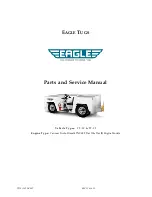
3
3‑3
DAILY CHECKS
OL1D-SM-GB02D
• Visually check level of oil in hydraulic oil tank.
The float in the bottom sight glass should
be at the top of the sight glass. If the level is
below this report to supervision immediately
and do not proceed any further with the daily
inspection.
PH2OHGB05-002
• Visually check for obvious damage to lamps,
warning beacons, reflectors and lenses and
bodywork.
• Check that all marking plates and warning
instruction labels are complete, clean, clearly
visible and readable (see ‘3.3 Warning labels’
• Visually check underneath (BUT DO NOT GO
UNDERNEATH THE VEHICLE) the Refuse
Collection Vehicle for evidence of hydraulic oil
leaks from the body system hydraulic pipes.
• Visually check the electrical harnesses
and connections, hoses, pipes and other
components for obvious signs of defects.
9. Arrange for an assistant to observe the operation
of body systems and lamps from a safe viewpoint
at the rear of the vehicle.
10. Enter the Refuse Collection Vehicle cab.
11. Check that all the emergency tools, equipment and
fire extinguisher are present.
12. Check that the first aid kit is complete.
3
Daily checks
It is important that your machine is kept in good
working order.
The following Daily safety checks must be carried
out on a Dennis Eagle Ltd. Refuse Collection Vehicle
to confirm the correct operation of the machine, its
controls, safety circuits and interlocks, in addition to
checks specified in the chassis‑cab manufacturer’s and
waste container lifting device manufacturer’s service
information, before it commences service.
The same checks should also be carried out by service
personnel whenever scheduled maintenance service
procedures and inspections are carried out or if a
major repair is made to the bodywork or it’s operating
systems.
Make sure that there is no mechanical damage or wear
evident in the refuse mechanism, especially in the
pivoting and locking of the tailgate to the body.
Any problems must be reported to supervision
immediately.
3.1
Daily safety checks
1. Stand the vehicle on clean, level and stable ground
with sufficient clearance to allow for the tailgate
and waste container lifting device, if fitted, to be
fully raised.
2. Engage the parking brakes.
3. Select Neutral ‘N’.
4. Stop the engine.
5. Turn the ‘Body main’ switch to the Off position.
Remove and retain the key.
6. Switch the ignition off. Remove and retain the key.
7. Lock all cab doors. Remove and retain the keys.
8. Walk around the Refuse Collection Vehicle and:
• Make sure that there is no refuse, paper
or flammable materials near the engine or
exhaust. These could cause a fire when the
engine is started. If necessary, tilt the cab
(see Chassis‑cab Manufacturer’s Operator’s
Handbook) to make a thorough inspection.
Summary of Contents for Dennis Eagle Olympus
Page 2: ......
Page 6: ...iv CONTENTS OL1D SM GB02D This page intentionally left blank ...
Page 8: ...1 1 2 INTRODUCTION OL1D SM GB02D This page intentionally left blank ...
Page 10: ...1 1 4 INTRODUCTION OL1D SM GB02D This page intentionally left blank ...
Page 12: ...2 2 2 HEALTH AND SAFETY OL1D SM GB02D This page intentionally left blank ...
Page 26: ...3 3 2 DAILY CHECKS OL1D SM GB02D This page intentionally left blank ...
Page 50: ...3 3 26 DAILY CHECKS OL1D SM GB02D This page intentionally left blank ...
Page 52: ...4 4 2 HYDRAULIC SYSTEM OIL LEVEL OL1D SM GB02D This page intentionally left blank ...
Page 60: ...5 5 2 CLEANING OL1D SM GB02D This page intentionally left blank ...
Page 66: ...6 6 2 SCHEDULED MAINTENANCE OL1D SM GB02D This page intentionally left blank ...
Page 90: ...8 8 2 GENERAL SPECIFICATION DATA OL1D SM GB02D This page intentionally left blank ...
Page 96: ...8 8 8 GENERAL SPECIFICATION DATA OL1D SM GB02D This page intentionally left blank ...












































